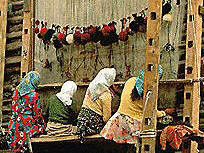|
More Resources on the same
topics |
|
Globalization imposes on developing countries
certain reform and adjustment programs in order to
improve their competitiveness and degree of
integration into the world economy, as explained
above.
Introduction:
Structural
adjustment is one of the main facets of
globalization within developing countries. The
conceptual framework of the impact of economic
policies on women lies in the writings that find
that the choice of policy instruments in ERSAP and
their impacts are all male biased. ERSAP
concentrates mainly on macro-economic policies to
reallocate resources as to achieve both stability
and growth rather than on micro economic issues and
gender differentiation.
However we believe that
three socio-economic factors
are responsible for the
male bias of ERSAP:
Sexual division of labor
implying
that some kind of the work is socially
constituted as women's work, while other
kind of work is considered as men's
work. Thus gender barriers are obstacles
against the reallocation of labor of
different sexes from one kind of work to
the other that might accompany ERSAP.
|
|
|
|
Examples of "Women's Work" |
| |
|
Loom Weaving
 |
|
 |

Girls Sewing |
|
| |
Pottery Making |
| |

Woman Sewing |
|
|
|
Neglect of unpaid domestic work
necessary for producing human resources
and the neglect of unpaid work outside
the household
It is the neglect of unpaid work inside
and outside the house. The explicit
exclusion of this work by economic
policies will lead to the sub-ordination
of women to men. As long as the
necessary resources for these programs
were not taken into consideration
women's capacity to reproduce and
maintain human resources has to extend
to overcome any shortcomings. However
after a certain time women's capacity
may collapse and this will be reflected
on women's health and nutrition status.
Neglect of the activities of women in
the household
This factor deals with whether ERSAP is adding to the women's
responsibility within the household without adding
to the resources women require to undertake her
responsibilities or not? |
|
| |
|
More Resources |
|
|
Tzannatos,
Zafiris (1998)
"Women
and Labor Market Changes in the Global
Economy: Growth Helps, Inequalities Hurt
and Public Policy Matters"
(New York : World Bank) |
|
|
|
Omran,Mohammrd(2001)
"Testing
for the Significant Change in the
Egyptian Economy under the Economic
Reform Programme Era"
Paper presented to WIDER Development
Conference on "Debt Relief" 17-18
August 2001 (Helsinki : Finland) |
|
|
|
Baden,Sally(1993)
"The
impact of recession and structural
adjustment on women's work in selected
developing countries"
Report prepared for the
Interdepartmental Project on "Equality
for Women in Employment" (Geneva:
International Labour Office) |
|
|
|
Nassar, Heba (1997)
Impact of Economic
Changes on Women’s Work.
A paper presented in the Conference on "Increase
in the Contribution of Women in Work”
(Alexandria: Friedrich Ebert Stiftung,
Ministry of Labor and Migration) |
|
|
|
ILO.(2001)
."National Workshop Report on:
Gender and
Employment in the context of Economic
Reform in Egypt" (Cairo : ILO) |
|
|
|
Gladwin, C., 1993, "Women and structural
adjustment in a global economy" in
Gallin, R., Ferguson, A. and Harper, J.
(eds), 1993,
The Women and International Development
Annual, Vol 3 (San Francisco:
Westview Press) |
|
|
|
Betcherman, Gordon (2002)
"An
Overview of Labor Markets World-Wide:
Key Trends and Major Policy Issues"
(New York: World Bank) |
|
|
|
|